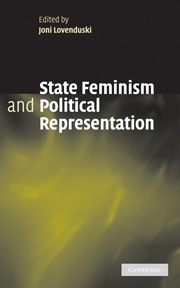Book contents
- Frontmatter
- Contents
- List of figures
- List of tables
- Notes on contributors
- Preface
- List of abbreviations
- 1 Introduction: state feminism and the political representation of women
- 2 Gendering political representation: debates and controversies in Austria
- 3 The Belgian paradox: inclusion and exclusion of gender issues
- 4 A politics for presence: state feminism, women's movements and political representation in Finland
- 5 Gendering the republican system: debates on women's political representation in France
- 6 WPAs and political representation in Germany
- 7 Gendering the debate on political representation in Italy: a difficult challenge
- 8 High tides in a low country: gendering political representation in the Netherlands
- 9 The women's movement, gender equality agencies and central-state debates on political representation in Spain
- 10 Party feminism, state feminism and women's representation in Sweden
- 11 Party government and women's representation debates: the UK
- 12 Women's policy agencies, the women's movement and representation in the USA
- 13 Conclusions: state feminism and political representation
- Appendix 1 Tables of women's representation in eleven countries
- Appendix 2 The RNGS model: summary of variable descriptors
- Index
- References
12 - Women's policy agencies, the women's movement and representation in the USA
Published online by Cambridge University Press: 22 September 2009
- Frontmatter
- Contents
- List of figures
- List of tables
- Notes on contributors
- Preface
- List of abbreviations
- 1 Introduction: state feminism and the political representation of women
- 2 Gendering political representation: debates and controversies in Austria
- 3 The Belgian paradox: inclusion and exclusion of gender issues
- 4 A politics for presence: state feminism, women's movements and political representation in Finland
- 5 Gendering the republican system: debates on women's political representation in France
- 6 WPAs and political representation in Germany
- 7 Gendering the debate on political representation in Italy: a difficult challenge
- 8 High tides in a low country: gendering political representation in the Netherlands
- 9 The women's movement, gender equality agencies and central-state debates on political representation in Spain
- 10 Party feminism, state feminism and women's representation in Sweden
- 11 Party government and women's representation debates: the UK
- 12 Women's policy agencies, the women's movement and representation in the USA
- 13 Conclusions: state feminism and political representation
- Appendix 1 Tables of women's representation in eleven countries
- Appendix 2 The RNGS model: summary of variable descriptors
- Index
- References
Summary
Introduction
Debates over political representation are pervasive in the USA. Pluralist by design, many of the country's core political values and institutional arrangements are premised on the belief that the number of voices in the process is at least as important as the outcome produced. Definitions of representation thus tend to focus on opportunities for participation in public decisions. A host of the key constitutional and statutory developments of the twentieth century are telling in this regard, including direct democracy, secret ballots, primaries, expanded voting rights, campaign finance reform, eased voter registration, and more. American affinity for the rhetoric of representation has hardly resulted in participatory parity, however. The US Congress remained less than 14 per cent female in 2003; the state legislatures averaged just 23 per cent women members (ranging from 37 per cent in Washington to 9 per cent in South Carolina); and only six women – a record – currently serve as governors.
Another aspect of representation in a democratic system, especially one so heavily draped in formal constitutionalism, is the manner in which citizens are identified under its governing document. The Equal Rights Amendment (ERA) of the 1970s and early 1980s addressed this matter with respect to sex. Its ratification would have produced both practical and symbolic effects. In the former case, most analyses conclude that it would have elevated the consideration of sex discrimination cases to the level of strict scrutiny, the judiciary's highest threshold for examining publicly sponsored differential treatment.
- Type
- Chapter
- Information
- State Feminism and Political Representation , pp. 239 - 259Publisher: Cambridge University PressPrint publication year: 2005



